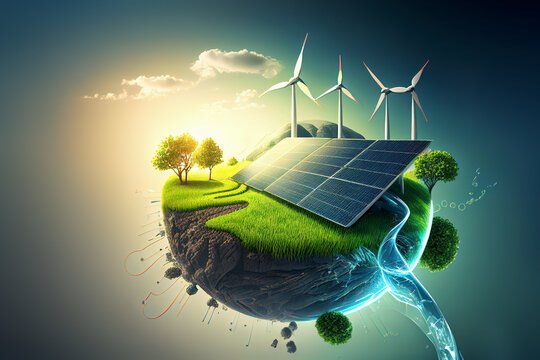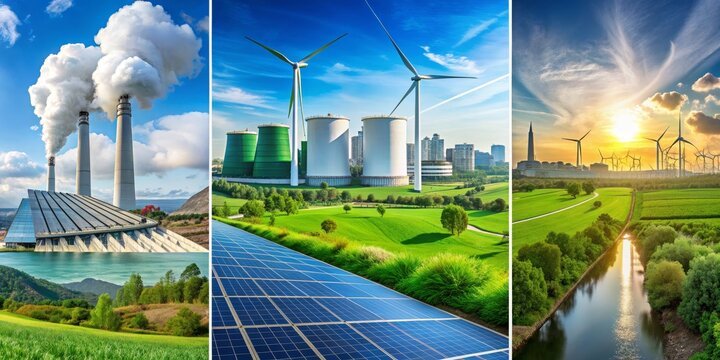The Rise of Green Energy in Cities
As urban areas continue to expand, the demand for energy is skyrocketing. With climate change concerns and the need for sustainable development, cities worldwide are rapidly adopting renewable energy technologies. This shift towards green energy is not just an environmental necessity but also an economic and social transformation.
Why Cities Are Turning to Renewable Energy

1. Growing Environmental Concerns
- Rising Air Pollution Levels: With increasing industrial activities, vehicular emissions, and energy consumption, air quality in urban areas is deteriorating. Renewable energy sources like solar and wind power produce minimal pollutants, making them crucial in reducing air pollution.
- Global Warming and Climate Change Threats: Greenhouse gas emissions from fossil fuels contribute to climate change, causing extreme weather events. Transitioning to renewable energy helps lower carbon footprints and mitigate these risks.
- Government Regulations and Environmental Policies: Governments worldwide are imposing stricter regulations on carbon emissions and promoting renewable energy through incentives, tax credits, and subsidies to encourage adoption.
2. Economic Benefits of Renewable Energy
- Lower Electricity Costs in the Long Run: While the initial investment in renewable energy infrastructure may be high, operational costs are significantly lower than fossil fuels, making them a cost-effective solution over time.
- Job Creation in the Renewable Energy Sector: The shift towards green energy has created millions of jobs in manufacturing, installation, maintenance, and research & development, supporting economic growth.
- Energy Independence and Reduced Reliance on Fossil Fuels: Many countries import fossil fuels, making them vulnerable to price fluctuations. Renewable energy sources provide stable and locally sourced energy, reducing dependency on foreign oil and gas.

3. Advancements in Green Technology
- Improved Efficiency of Solar Panels and Wind Turbines: Modern solar panels and wind turbines are more efficient, producing more energy with fewer resources.
- Smart Grid Systems Enabling Better Energy Management: Smart grids optimize electricity distribution by integrating renewable energy sources seamlessly with conventional grids.
- Integration of Artificial Intelligence (AI) in Energy Optimization: AI-driven energy management systems predict consumption patterns, optimize energy use, and reduce wastage, making renewable energy more efficient.
Types of Renewable Energy Technologies Transforming Urban Areas
1. Solar Energy: The Most Popular Urban Renewable
- Rooftop Solar Panels: Many homes, businesses, and apartment complexes are installing rooftop solar panels to generate electricity, reducing dependence on the grid.
- Solar Farms: Large-scale solar farms are strategically built near cities to generate significant amounts of clean energy for urban centers.
- Solar-Powered Streetlights: Public lighting powered by solar energy reduces energy costs and enhances sustainability in urban planning.
- Solar Windows and Facades: Buildings are incorporating photovoltaic glass to generate energy while maintaining aesthetic appeal.

2. Wind Energy in Urban Landscapes
- Small-Scale Wind Turbines: Installed on rooftops and urban structures, these turbines harness wind energy without requiring vast open spaces.
- Offshore Wind Farms: Located near coastal cities, offshore wind farms generate massive amounts of energy while minimizing land use concerns.
- Hybrid Systems: Integrating wind and solar power ensures a continuous energy supply, even when weather conditions fluctuate.
3. Hydropower & Water Energy Solutions
- Micro Hydropower Systems: Small-scale hydropower stations harness energy from water flow in urban canals and reservoirs.
- Tidal and Wave Energy: Coastal cities are experimenting with tidal and wave energy to generate electricity sustainably.
- Rainwater Collection for Energy: Some cities are exploring ways to convert rainwater flow into kinetic energy for power generation.
4. Geothermal Energy: Heating and Cooling for Cities
- Geothermal Heat Pumps: These pumps use the earth’s constant underground temperature to provide heating and cooling solutions, reducing energy consumption.
- Underground Reservoirs: Hot water reservoirs beneath cities can be tapped for sustainable energy production.
- District Heating Systems: Some urban areas have implemented geothermal district heating, supplying multiple buildings with centralized heating solutions.
5. Bioenergy: Waste to Power
- Biogas Plants: Organic waste from households and industries is converted into methane gas, used for electricity generation.
- Biomass Power Stations: Utilizing plant-based materials, biomass power stations generate sustainable electricity while reducing agricultural waste.
- Algae-Based Biofuels: Research into algae biofuels is showing promising results in replacing traditional fossil fuels for urban transport.

Challenges in Implementing Renewable Energy in Cities
1. High Initial Investment Costs
- Expensive Infrastructure Development: Building solar farms, wind turbines, and smart grids require significant investment.
- Funding Limitations for Small Businesses and Homeowners: Despite incentives, upfront costs can be a barrier for small-scale renewable energy adoption.
2. Space Constraints in Urban Areas
- Lack of Available Land for Large-Scale Renewable Energy Projects: Finding suitable land in dense urban areas is challenging.
- Need for Innovative Solutions Like Vertical Solar Panels and Floating Solar Farms: Space-saving designs such as solar panels on high-rise buildings and floating solar farms on water bodies are gaining traction.
3. Energy Storage and Grid Integration Issues
- Limited Battery Storage Capacity: Renewable energy sources are intermittent, requiring improved storage solutions to ensure continuous supply.
- Difficulties in Integrating Renewable Sources into the Existing Power Grid: Traditional power grids must be upgraded to handle decentralized energy production.
4. Public Awareness and Policy Gaps
- Need for Better Incentives and Subsidies for Adopting Green Energy: Government support is essential for encouraging mass adoption.
- Lack of Awareness Among Residents About the Benefits of Renewable Technologies: Public education and outreach programs are necessary to promote renewable energy adoption.
Success Stories: Cities Leading the Renewable Energy Revolution
1. Copenhagen, Denmark
- Aiming to become carbon-neutral by 2025
- Extensive use of wind energy and district heating systems
2. San Diego, USA
- Over 40% of electricity from renewable sources
- Large-scale solar energy adoption and green building initiatives
3. Tokyo, Japan
- Pioneering in solar energy for residential buildings
- Smart grid implementation for efficient energy distribution
Future of Renewable Energy in Urban Areas
1. Smart Cities and AI Integration
- AI-driven energy consumption management optimizes urban energy use.
- IoT-enabled smart grids for real-time energy monitoring enhance efficiency.
2. Energy Storage Innovations
- Advancements in battery technology, such as lithium-ion and solid-state batteries, improve energy storage capacity.
- Development of hydrogen fuel cells for long-term energy storage and sustainable transport.
3. Increased Government Support and Global Policies
- Stricter carbon emission laws drive investments in green technology.
- Financial incentives and subsidies encourage widespread adoption of renewable energy solutions.
Conclusion: A Greener Tomorrow
The rapid growth of renewable energy in urban areas is reshaping the way cities function. While challenges remain, technological advancements, economic benefits, and environmental necessity are driving this transformation. With continued innovation and policy support, the future of urban energy is undoubtedly green and sustainable.
The Ethical Implications of AI in Content Creation: A Deep Dive






